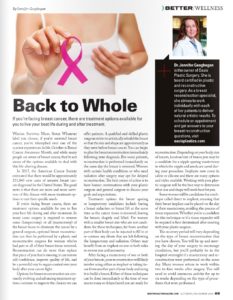Treatment options for breast cancer
If you’re facing breast cancer, there are treatment options available for you to live your best life during and after treatment.
By Dr. Jennifer Geoghegan
Warrior. Survivor. Mom. Sister. Whatever label you choose, if you’ve survived breast cancer, you’ve triumphed over one of the scariest experiences in life. October is Breast Cancer Awareness Month, and while many people are aware of breast cancer, they’re not aware of the options available to deal with this life-altering disease.
In 2015, the American Cancer Society estimated that there would be approximately 231,840 new cases of invasive breast cancer diagnosed in the United States. The good news is that there are more and more survivors of this disease with more treatment options to suit their specific needs.
If you’re facing breast cancer, there are treatment options available for you to live your best life during and after treatment. In many cases surgery is required to remove some (lumpectomy) or all (mastectomy) of the breast tissue to eliminate the cancer by a general surgeon, optional breast reconstruction can then be performed by a plastic and reconstructive surgeon for women who’ve had part or all of their breast tissue removed. Reconstruction can do more than replace that piece of you that is missing, it can restore self-confidence, improve quality of life, and be a powerful way to regain control over your body after your cancer fight.
Options for breast reconstruction are constantly evolving and advancing treatment options continue to improve the choices we can offer patients. A qualified and skilled plastic surgeon strives to artistically rebuild the breast so that the size and shape are approximately as they were before breast cancer. You can begin to plan for breast reconstruction immediately following your diagnosis. For some patients, reconstruction is performed immediately on the same day the breast is removed. Women with certain health conditions or who need radiation after surgery may opt for delayed reconstruction. The best course of action is to have honest conversations with your plastic surgeon and general surgeon to discuss your goals and expectations.
Treatment options for breast sparing or lumpectomy candidates include having a breast reduction or breast lift at the same time as the cancer tissue is removed, leaving the breasts shapely and lifted. For women with a smaller breast size that are not candidates for those techniques, fat from another part of their body can be injected to fill in or re-contour any divots that are left following the lumpectomy and radiation. Others may benefit from an implant on one or both sides to restore size and symmetry.
After facing a mastectomy of one or both of your breasts, your reconstruction will likely involve using either an implant or taking tissue from another part of your body and using it to build a breast. Either of these techniques can be done immediately at the time of your mastectomy or delayed until you are ready for reconstruction. Depending on your body, size of breasts, location/size of tumor, you may be a candidate for a nipple sparing mastectomy in which the nipple and areola are saved during your procedure. Implants now come in saline or silicone and there are many options and styles available. Working with your plastic surgeon will be the best way to determine what size and shape will work best for you.
Some women will be candidates for a technique called direct to implant, meaning that their breast implant can be placed on the day of their mastectomy, avoiding the process of tissue expansion. Whether you’re a candidate for this technique or if a tissue expander will be required is best determined after meeting with your plastic surgeon.
The recovery period will vary depending on the type of breast reconstruction that you have chosen. You will be up and moving the day of your surgery to encourage circulation, but you’ll probably be in the hospital overnight if a mastectomy and reconstruction were performed on the same day. Many women return to work within two to four weeks after surgery. You will need to avoid strenuous activity for up to six weeks depending on the type of procedures that were performed.
Dr. Jennifer Geoghegan is the owner of Oasis Plastic Surgery. She is board certified in plastic and reconstructive surgery. She strives to work individually with each of her patients to deliver natural artistic results. To schedule an appointment and get answers to your breast reconstruction questions, visit oasisplastics.com.
Related posts
Leave a Comment
You must be logged in to post a comment.







